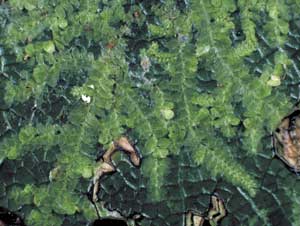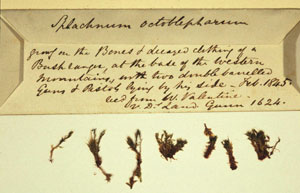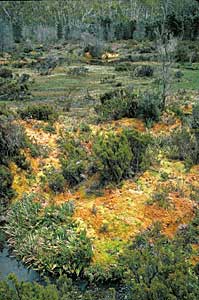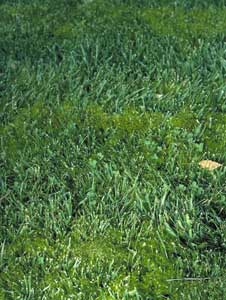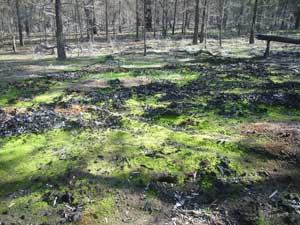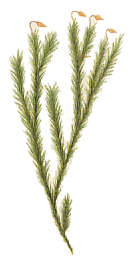
Ecology
You can find bryophytes from the cold arctic and antarctic to the hot deserts of the world and from sea level to alpine peaks. Some species may be found in a wide variety of habitats while others have a very restricted range. You can find bryophytes growing on a wide variety of natural and man-made substrates. It should therefore not surprise you to learn that, as a group, bryophytes show a wide range of behaviours and interactions with other organisms. Bryophyte ecology is clearly a large subject so that, necessarily, there will be a fairly limited coverage on this website. There will be specific references for many of the topics. If you click on the following button you will find some general references, which provide good starting points for further study.
Over time you will find much additional information on the Bryophyte Ecology website that Janice Glime is developing. Some sections of that website have already been completed![]() .
.
You'll often find bryophytes growing with other non-vascular cryptogams such as lichens, algae and cyanobacteria. If you're not familiar with these organisms, or the word "cryptogam", you'll find brief explanations in the WHAT'S NOT A BRYOPHYTE SECTION. They'll feature in some of these ecology pages because bryophytes are often found in association with them.
Substrates
Most people will have seen bryophytes growing on soil, rocks ![]() and tree trunks. These are very common substrates throughout most of the world. You can also find bryophytes on the leaves of vascular plants, especially in the tropics. These are called EPIPHYLLOUS BRYOPHYTES and you can find out more by clicking on that link. In humid forests you can even find bryophytes growing on invertebrates. Leafy liverworts in the genera Lejeunea, Cololejeunea, Odontolejeunea and Microlejeunea; the thallose liverwort genus Metzgeria and the moss Daltonia angustifolia have been found on beetles in New Guinea. The beetles often have ridges, depressions or hairy to bristly surfaces that aid in trapping propagules of bryophytes, lichens, algae and fungi. Similar species grow in the surrounding vegetation so the beetles are camouflaged by having growths of bryophytes and other organisms listed above. The leafy liverwort Taxilejeunea obtusangula was found growing with several algae on the head of the Mexican rainforest lizard species Corythophanes cristatus. The lizard may stay still for hours, moves slowly and the top of its head is slightly concave, ideal for catching moisture dripping from above. These characteristics would also ensure that liverwort propagules are readily caught, as well as providing a site conducive to gametophytic growth. It is unlikely that the liverwort would ever reach sexual maturity since the lizards possibly shed their skins more than once a year. The liverwort is widespread in the Neotropical rainforests where it is commonly found on bark or living leaves
and tree trunks. These are very common substrates throughout most of the world. You can also find bryophytes on the leaves of vascular plants, especially in the tropics. These are called EPIPHYLLOUS BRYOPHYTES and you can find out more by clicking on that link. In humid forests you can even find bryophytes growing on invertebrates. Leafy liverworts in the genera Lejeunea, Cololejeunea, Odontolejeunea and Microlejeunea; the thallose liverwort genus Metzgeria and the moss Daltonia angustifolia have been found on beetles in New Guinea. The beetles often have ridges, depressions or hairy to bristly surfaces that aid in trapping propagules of bryophytes, lichens, algae and fungi. Similar species grow in the surrounding vegetation so the beetles are camouflaged by having growths of bryophytes and other organisms listed above. The leafy liverwort Taxilejeunea obtusangula was found growing with several algae on the head of the Mexican rainforest lizard species Corythophanes cristatus. The lizard may stay still for hours, moves slowly and the top of its head is slightly concave, ideal for catching moisture dripping from above. These characteristics would also ensure that liverwort propagules are readily caught, as well as providing a site conducive to gametophytic growth. It is unlikely that the liverwort would ever reach sexual maturity since the lizards possibly shed their skins more than once a year. The liverwort is widespread in the Neotropical rainforests where it is commonly found on bark or living leaves![]() .
.
Glass, plastic, rubber, roof tiles, dung, bones and carcases – all can be found with bryophytes growing on them. Consider this photo, which shows a moss specimen collected in 1845 in Tasmania. The accompanying hand-written note reads:
Splachnum octoblepharum (click to enlarge photo) Growing on the Bones & decayed clothing of a Bushranger, at the base of the Western Mountains, with two double-barrelled Guns & Pistols lying by his side. Feb. 1845. rec'd from W. Valentine. v. D's Land. Gunn 1624. |
The photo was taken by Alan Fife, of Landcare Research, New Zealand and he has kindly allowed it's use on this website. The specimen in the photo is now held by The British Museum and there is a duplicate of this specimen in the Tasmanian Herbarium. The expression "v. D'S Land" is an abbreviation for "van Diemen's Land", the old name for Tasmania. Ronald Gunn was a 19th century Tasmanian botanist and the specimen in question is number 1624 amongst his collections. The modern name for this species is Tayloria octoblepharum and it is also found on soil or dung. Here's a photo ![]() showing some fresh specimens.
showing some fresh specimens.
Habitats
There are various factors which determine where you will find a particular species of bryophyte. Examples of such factors are: climate (including aspects such as yearly temperature and rainfall patterns); substrate chemistry (e.g. whether it's alkaline or acidic); physical factors such as surface texture, degree of shading; the nature of the surrounding vascular plants; pollution level. There are species that are restricted to very specific habitats and others are found in more than one habitat. Bryum argenteum is a very widespread (perhaps the most widespread) moss in the world. You'll find it from the pavements of the world's major cities to the ice-free areas of the Antarctic. You will find bryophytes from forests that have been without major disturbance for decades to fields that are ploughed annually. While most bryophytes are terrestrial there are also some aquatic bryophytes. You may find a bryophyte colony growing in some spot but, no matter how long you watch, never find that species growing even a centimetre away because of micro-habitat preferences. There's much more about all this in the HABITATS SECTION.
Water, erosion and nutrient recycling
Bryophytes can hold from just a few times to many times their own weight in water, depending on species. The best performers are found in the genus Sphagnum and are capable of holding between 20 and 30 times their own weight in water. Moreover, bryophytes can quickly absorb water which is then released over a much longer period. Alpine Sphagnum bogs may hold on to much of the water that results from the spring snow melt. Rather than all this water quickly flowing away in alpine streams, it is fed into streams over a much more extended period, resulting in a more even stream flow. There's more about this genus in the SPHAGNUM SECTION. Bryophytes on tree trunks absorb rainwater that's flowing down the trunk and those hanging like curtains ![]() absorb water, both from rainfall and from mists or fogs. The curtain-like mosses, because of their very large surface areas are very efficient exploiters of mists or fogs. A fist-sized clump of moss on a tree trunk can hold as much water as a similar sized sponge. Moist clumps or curtains, especially if they are abundant as they are in many tropical areas, help maintain a humid atmosphere and so greatly influence the micro-climate. Bryophytes will also trap any nutrients that are dissolved in the rain or mist droplets, in many cases trapping nutrients that would otherwise be washed away. Living bryophytes make use of the nutrients they trap and dead, decaying bryophytes release nutrients to the surrounding plants. In these ways bryophytes play an important role in nutrient recycling.
absorb water, both from rainfall and from mists or fogs. The curtain-like mosses, because of their very large surface areas are very efficient exploiters of mists or fogs. A fist-sized clump of moss on a tree trunk can hold as much water as a similar sized sponge. Moist clumps or curtains, especially if they are abundant as they are in many tropical areas, help maintain a humid atmosphere and so greatly influence the micro-climate. Bryophytes will also trap any nutrients that are dissolved in the rain or mist droplets, in many cases trapping nutrients that would otherwise be washed away. Living bryophytes make use of the nutrients they trap and dead, decaying bryophytes release nutrients to the surrounding plants. In these ways bryophytes play an important role in nutrient recycling.
In arid areas extensive carpets of lichens, bryophytes and cyanobacteria play important ecological roles. Such cryptogam carpets are called BIOLOGICAL SOIL CRUSTS and one of their major functions is erosion control. Both lichens and bryophytes commonly have root-like structures (but not true roots) to anchor themselves to the soil. In arid areas rainfall often comes as sudden, intense downpours. As well as having root-like appendages which help bind the soil, a biological soil crust also forms a physical barrier between the falling raindrops and the soil. This means that much of the raindrops' force is absorbed by the crust and this greatly lessens the erosive potential of such intense downpours. In addition, such a crust will often slow down the flow of water and thereby lengthen the time during which the water can soak into the underlying soil.
Colonisers
From what has already been said about bryophyte substrates and habitats, it's not surprising to learn that bryophytes are often among the first organisms to colonize bare surfaces. Examples of these are the bare soil expanses such as those exposed during road works or by landslides, volcanic ash deposits, the scorched soil and charred wood left after a severe bushfire, freshly exposed rock faces, new footpaths, freshly tiled roofs and the upturned soil in a newly ploughed field. Bare soil may often be colonized as readily by pioneering vascular plants as by bryophytes and other cryptogams. On the other hand surfaces such as bare rock and thick volcanic ash are initially barren, nutrient-poor and often exposed to sun and wind. Such surfaces are inimical to the seeds of vascular plants but are readily colonised by various non-vascular cryptogams, among which various bryophytes and the bulkier lichens are good at trapping windblown organic debris. Of course, the bryophytes and other cryptogams also contribute to the organic deposits when they themselves die and decay. Death may be of the whole or just a part of the organism. A good example of the latter involves those pioneering mosses that grow as individual, upright stems but close enough to one another to form cushions. In such a cushion, as the stems grow, the lower leaves lose their access to light and die, thereby adding to the organic debris. This photo ![]() shows a small section through such a cushion. You can see the live, green leaves above a layer of dead material. So, in one way or another, bryophytes help build up a layer of organic matter. This provides homes for various micro-organisms and invertebrates, as well as potential seed beds for vascular plants. The next section discusses the complexity of the interactions between bryophytes and plant seeds. For the moment it will be enough to note that the pioneer bryophytes often help pave the way for the transformations of many bare surfaces into ones that will eventually support complex plant communities and intricate food chains. Of course some barren surfaces (such as footpaths and roof tiles) will never support complex vascular plant communities. However, they may still support complex communities of cryptogams, invertebrates and micro-organisms. Another thing to note is that over time there may be a change in the species present in any area. Certain species are quick colonizers of disturbed areas – but are then replaced by others.
shows a small section through such a cushion. You can see the live, green leaves above a layer of dead material. So, in one way or another, bryophytes help build up a layer of organic matter. This provides homes for various micro-organisms and invertebrates, as well as potential seed beds for vascular plants. The next section discusses the complexity of the interactions between bryophytes and plant seeds. For the moment it will be enough to note that the pioneer bryophytes often help pave the way for the transformations of many bare surfaces into ones that will eventually support complex plant communities and intricate food chains. Of course some barren surfaces (such as footpaths and roof tiles) will never support complex vascular plant communities. However, they may still support complex communities of cryptogams, invertebrates and micro-organisms. Another thing to note is that over time there may be a change in the species present in any area. Certain species are quick colonizers of disturbed areas – but are then replaced by others.
Bryophytes and other plants
As noted in the preceding section, bryophyte mats may provide ideal sites for the germination of vascular plant seeds. You may well have seen seedlings growing out through bryophyte carpets on the ground ![]() . In moister forests it's fairly common to see orchids, ferns and other vascular plants growing from moss-covered tree trunks and boulders. You can get quite large bryophyte mats on trees, rocks and especially on the ground
. In moister forests it's fairly common to see orchids, ferns and other vascular plants growing from moss-covered tree trunks and boulders. You can get quite large bryophyte mats on trees, rocks and especially on the ground ![]() . In an otherwise barren area such a mat can provide a fairly stable micro-habitat, protected against the drying effects of sun and wind and the extremes of temperature. Understandably the degree of protection varies with the type of bryophyte growth. Therefore a seed that falls into such a carpet could find itself in a relatively sheltered micro-habitat that is conducive to successful germination. Moreover, a seed that's out of sight is protected against many seed-eating insects, birds and mammals.
. In an otherwise barren area such a mat can provide a fairly stable micro-habitat, protected against the drying effects of sun and wind and the extremes of temperature. Understandably the degree of protection varies with the type of bryophyte growth. Therefore a seed that falls into such a carpet could find itself in a relatively sheltered micro-habitat that is conducive to successful germination. Moreover, a seed that's out of sight is protected against many seed-eating insects, birds and mammals.
That's not to say that all bryophyte mats are ideal nurseries for all vascular plant seeds. Suppose a seed finds itself caught on, or near, the top of a mat growing on the ground. When such a seed germinates there is the possibility that the embryonic seedling runs out of food reserves, and dies, before the root is able to reach the ground. That could be the case if the mat is deep enough. Alternatively, a seed on the ground at the bottom of a dense bryophyte cover may germinate, establish a good root but die through being shaded out. The fate of a particular seed depends on both the nature of the seed and that of the bryophyte carpet it finds itself with. A seedling from a larger seed, with greater food reserves, can survive where a smaller seedling suffers. A dense bryophyte carpet will have a different effect to a sparse one and the influence of a thick carpet is not the same as that of a thin one.
As well as physical considerations there are also chemical effects. Experiments have shown that bryophyte extracts may have positive or negative effects on vascular plant seedlings. Moreover, the extract from a given bryophyte may promote the growth of seedlings of some plant species while inhibiting such growth in other plant species – and it may have no effect on the seedlings of yet other vascular plant species. Sphagnum bogs are generally inimical to vascular plants and there's more about this in the SPHAGNUM SECTION.
|
Having read all of this you might believe that it's true when people complain about mosses killing their lawns, but read the accompanying box. It's also important to realize that the influences aren't all one way. The vascular plants present in a particular area will have various effects on bryophytes. To give a simple example, a tree that drops copious amounts of litter will very likely create a bryophyte desert below the tree canopy. The falling litter will smother any bryophytes that may start growing under the tree and so kill them by depriving them of access to light. Even if the litter fall isn't dense enough to stop bryophyte growth it may influence which species can grow nearby depending, for example, on whether the litter is alkaline or acidic. While bryophytes are among the early colonisers of bare areas, as vascular plants establish, many of the colonising bryophytes will find themselves overgrown and deprived of light.
Of course, bryophytes themselves are plants. So, when talking about interactions with plants we must remember that there are also interactions between different bryophytes. Bryophytes compete for space and resources. A larger or faster growing species may out compete a slower growing species, but sometimes the effect of a third party may ensure the continued survival of both the slower and the faster growing species. A little earlier you saw that bryophyte chemicals can influence seed germination and seedling behaviour. Such chemicals may also have effects on bryophytes, for example by inhibiting or stimulating spore germination or protonemal growth.
Bryophytes and other cryptogams
Other cryptogams can be found growing with bryophytes. Various algae and cyanobacteria may benefit from the shelter offered by bryophyte mats, particularly in the harsher environments. On sub-Antarctic Signy Island the algae growing with mosses were found to be an important food source for other organisms. Some green algae grow inter- or intra-cellularly in moss leaves, not necessarily causing any damage. BRYOPHYTES AND CYANOBACTERIA form a variety of associations, as you can find out by following that link![]() .
.
There are two broad groups of fungi – those that form a lichen partnership with a photosynthesizing organism and those that don't. The latter are discussed in more detail in the BRYOPHYTES AND FUNGI SECTION. You'll very often see lichens growing with bryophytes, so the two are potential competitors and a variety of lichen-bryophyte interactions do occur. Crustose lichens look like thin skins or simple washes of paint on the underlying soil, rock or wood. At first it would appear that such simple, two-dimensional growth forms could be easily overgrown by many bryophytes. In fact some crustose lichens are very effective at keeping bryophytes away, quite likely with chemical defences. Lichens produce a wide variety of chemical compounds, some of which have negative effects on bryophytes - acting to prevent spore germination or inhibiting protonemal or gametophytic growth![]() .
.
There is a small number of lichens which are soft and gelatinous when moist, but which dry to a hard crust. The same is true of various algae and cyanobacteria. When these are found growing amongst bryophytes the dry, crusty states could easily kill the embedded bryophytes by suffocation.
In a lichen partnership the fungus cannot survive without the photobiont. Many lichens produce spores of the fungal partner, for example in cup-like or disk-like structures you can easily see on many lichens. The spores are usually dispersed by the wind and can form new lichens if they germinate near the appropriate alga or cyanobacterium. In some cases the fungus can parasitize bryophyte protonemata for a short time, giving it a little more time in which to encounter a suitable alga or cyanobacterium so that the lichen association can be formed. In the late 1800s the French botanist G. Bonnier was able to establish short-term fungus/protonema associations. He noted that the protonema would eventually be killed. In the BAEOMYCES RUFUS CASE STUDY you can read about the cyclic nature of a particular bryophyte-lichen interaction. The lichen Baeomyces rufus can grow over bryophyte mats or cushions and kill them by depriving them of access to light. After a few years the lichen itself dies, decays and bryophytes can re-colonize the area. However, the lichen has produced propagules from which fresh lichens can grow in the surrounding area and this cycle continues.
Bryophytes as food and shelter
Many animals make use of bryophytes. Numerous invertebrates eat bryophytes, lay their eggs on them or shelter in them. They form a vital part of the construction material of the nest of some birds ![]() .When it comes to vertebrates the range of associations is much less. In south-east Australia the Southern Corroboree Frog, (Pseudophryne corroboree ) and the Northern Corroboree Frog
.When it comes to vertebrates the range of associations is much less. In south-east Australia the Southern Corroboree Frog, (Pseudophryne corroboree ) and the Northern Corroboree Frog ![]() (Pseudophryne pengilleyi ) are found near Sphagnum bogs . These endangered frogs breed in Sphagnum bogs in the alpine and sub-alpine areas of NSW and the ACT but move away from boggy areas outside of the breeding season. Mosses have a low nutritional value and are usually ignored by the larger animals when other food is available. For example, a reindeer would need to eat 7 kg of moss to get the same energy it can get from half a kilogram of tundra grass. Yet some arctic animals (including reindeer) scoff moss down. Barnacle geese that migrate north to arctic breeding grounds start eating moss as soon as they arrive. These mosses contain high levels of arachidonic acid, which helps cells to keep working at low temperatures. In effect the mosses are supplying the animals with a natural antifreeze compound.
(Pseudophryne pengilleyi ) are found near Sphagnum bogs . These endangered frogs breed in Sphagnum bogs in the alpine and sub-alpine areas of NSW and the ACT but move away from boggy areas outside of the breeding season. Mosses have a low nutritional value and are usually ignored by the larger animals when other food is available. For example, a reindeer would need to eat 7 kg of moss to get the same energy it can get from half a kilogram of tundra grass. Yet some arctic animals (including reindeer) scoff moss down. Barnacle geese that migrate north to arctic breeding grounds start eating moss as soon as they arrive. These mosses contain high levels of arachidonic acid, which helps cells to keep working at low temperatures. In effect the mosses are supplying the animals with a natural antifreeze compound.
Pollution
Just as bryophytes will readily absorb water and nutrients through their surfaces, so will they also readily absorb a wide variety of potentially toxic compounds. The effects of pollutants vary, depending on the pollutant and the species of bryophytes but, even within species there are variations. Some populations are more resistant than others. The stage of development is also important, some pollutants inhibiting or having a considerable effect during spore germination or on protonemal growth, but a less pronounced effect on a well-established gametopyhte. This section will give just a few examples, to show some ways in which pollutants affect bryophytes![]() .
.
Pollutants come in many forms from both urban and rural areas. Sulfur dioxide has been a significant industrial pollutant for many years, being a by-product of the use of high sulfur fuels. While sulfur-removal technology has reduced the level of sulfur dioxide pollution in many countries, it is still a significant pollutant in many areas. Smelters produce heavy metal pollutants, cars produce nitrogen oxides and nuclear reactors produce radioactive pollutants. With the increase in intensive animal rearing ammonia is becoming a significant rural pollutant and agricultural chemicals such as fertilizers and herbicides make their way into soil and waterways. Pollutants may come as gases, as microscopic particles or in solution. For example sulfur dioxide, a gas, dissolves readily in water to produce highly reactive acidic ions, which are readily absorbed through bryophyte thalli or leaves and, once absorbed, disrupt photosynthesis. Sulfur dioxide is very damaging but some bryophytes are highly tolerant of sulfur dioxide pollution and examples of these are the mosses Funaria hygrometrica and Bryum argenteum ![]() . There are others which are not necessarily inherently resistant to sulfur dioxide but which may be protected when growing on alkaline substrates (such as mortar). Even in species which are susceptible to sulfur dioxide environmental factors (other than alkaline substrates) are important in determining the level of damage. Bryophytes absorb far less sulfur dioxide as they dry out. Typically in temperate areas winters are wet and summers are dry, with bryophytes therefore spending much of the summer in a dormant, dry state. It is during the cooler, moister months that temperate area bryophytes are more likely to be metabolically active and it is then that toxic compounds would have their most damaging effects. Therefore, in a temperate area, the winter sulfur dioxide levels are important in determining if that pollutant presents a threat to the bryophytes of the area
. There are others which are not necessarily inherently resistant to sulfur dioxide but which may be protected when growing on alkaline substrates (such as mortar). Even in species which are susceptible to sulfur dioxide environmental factors (other than alkaline substrates) are important in determining the level of damage. Bryophytes absorb far less sulfur dioxide as they dry out. Typically in temperate areas winters are wet and summers are dry, with bryophytes therefore spending much of the summer in a dormant, dry state. It is during the cooler, moister months that temperate area bryophytes are more likely to be metabolically active and it is then that toxic compounds would have their most damaging effects. Therefore, in a temperate area, the winter sulfur dioxide levels are important in determining if that pollutant presents a threat to the bryophytes of the area![]() .
.
This website, produced by the National Environment Research Council of the United Kingdom presents a short report about the effects of atmospheric nitrogen pollution. In another experiment that subjected the moss Polytrichum formosum to the nitrogen dioxide concentrations found alongside rural British roads, growth was first stimulated but later there were significant reductions in old shoots and in new shoot formation![]() .
.
A Finnish study of plant growth near a smelter found mosses virtually absent and that it was only about 8 kilometres away from the smelter that bryophyte diversity reached the normal levels found in the forests of the region. As an illustration of the variability in sensitivity Pohlia nutans, a pioneering moss species, could be found growing in the immediate vicinity of the smelter. Studies of the moss Ceratodon purpureus have suggested that it is capable of evolving resistant populations relatively rapidly in response to metal-contaminated soils. Metal tolerance is not confined to the mosses. There are metal-tolerant populations of the thallose liverwort Marchantia polymorpha and the leafy liverwort Solenostoma crenulata. The resources put into metal tolerance do have a biological cost, since those resources are not available for other uses. The consequences could, for example, be slower or sparser growth or the production of fewer antheridia or archegonia. When grown on non-polluted soils a metal-tolerant variety is typically less competitive than a metal-sensitive variety of the same species. Similar results have been found for metal-tolerant flowering plants. While on the subject of heavy metals it's worth mentioning a group of mosses commonly called copper mosses. The phrase turns up often, with claims that the mosses can live only where copper is present. However they also live where various other heavy metals are present and it seems more the case that these mosses are always found in areas where heavy metal sulfides are produced. Unlike the copper mosses species such as the Pohlia and Ceratodon mentioned above can be found in areas with a negligible heavy metal presence![]() .
.
In Dutch fens, subject to eutrophication from agricultural chemicals, the moss Calliergonella cuspidata has been replacing the moss Scorpidium scorpioides and increased nutrients are the cause. However, the two species show little difference in response to the increased nutrients themselves. Rather, experiments indicate that Calliergonella benefits indirectly. With increased nutrients there's increased growth of the vascular fen plants and increased vascular litter production, especially above the water level. Calliergonella can grow in both wet and dry conditions while Scorpidium is confined to wet environments. The increased litter above the water level provides a substrate that Calliergonella, but not Scorpidium, can exploit![]() .
.
Fire
Wildfires are a common phenomenon in many parts of the world and have been so for numerous millennia. In Australia it would be very unusual to have a summer without at least one serious bushfire somewhere in the country. Fires come in a variety of forms and are influenced by what they're burning (eg grass versus timber), the local landscape (eg flat, hilly, boulder-strewn) and local weather conditions during the blaze. Consequently the effects on bryophytes are also varied. A rapid fire that burns relatively coolly may leave much of the bryophyte community untouched. Suppose, for example, that a fire is unable to ignite fallen logs or burn for long around boulders. The bryophyte colonies on those logs or boulders may suffer a little damage, with some plants dying, but with the bulk of the communities surviving unscathed. By contrast a slow, hot fire would reduce those logs to charcoal and, very likely, would scorch many of the boulder-living communities. In the second scenario the bulk of the bryophytes would perish. In addition, the soil will have been severely scorched and the creation of great quantities of ash will have increased the alkalinity of the ground. In the first scenario, with little ash, there is no shift in soil chemistry and the areas disturbed by the fire are likely to be colonised by the species that were present in the surrounding area immediately before the fire. In the second the scene is set for colonisation by pioneer ash-bed specialists. Studies, both overseas and Australian, show that the cosmopolitan moss Funaria hygrometrica ![]() is an early coloniser of burnt areas. Gametophytes may appear within a few weeks after a fire. Marchantia, a thallose liverwort genus, also provides some early colonisers, with Marchantia polymorpha recorded commonly in northern hemisphere studies and Marchantia berteroana in Australian and New Zealand. Over time other species will appear and so give rise to a species succession. You can read more in the section about FIRE.
is an early coloniser of burnt areas. Gametophytes may appear within a few weeks after a fire. Marchantia, a thallose liverwort genus, also provides some early colonisers, with Marchantia polymorpha recorded commonly in northern hemisphere studies and Marchantia berteroana in Australian and New Zealand. Over time other species will appear and so give rise to a species succession. You can read more in the section about FIRE.
![An Australian Government Initiative [logo]](/images/austgovt_brown_90px.gif)


